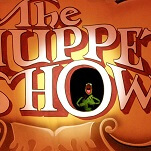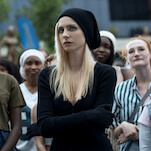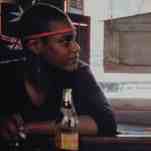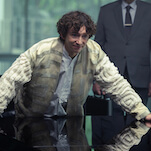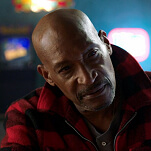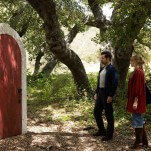On one page of Lilli Carré’s short story “Rainbow Moment,” an elderly bookstore owner recalls an evening outing with her uncle, and how they kept spotting blobs on the horizon that they thought were bats, but that were actually objects that had no business being where they were—like a baby kangaroo, and a woman kicking a hill. That’s a motif that Carré returns to throughout her outstanding new collection Heads Or Tails (Fantagraphics): shapes and figures that can be refashioned, or at least viewed differently, until they become something other than what they initially appear. The bat scene in “Rainbow Moment” is also a story within a story within a story (with two further layers of story still to come), and includes a moment when the character who hears the bat tale is stuck between narrow bookshelves, contorted by literature itself. This matches an image in the first piece of Heads Or Tails, “Welcome To My Kingdom,” in which a dapper man gets boxed in, page-by-page, by the filigree that Carré keeps adding. Carré loves to constrict her characters, because she knows that limiting their options won’t necessarily limit their imaginations.
Carré is unusual among cartoonists in that she’s not locked in to any one particular style. Her characters tend to have a similar look—a little like fleshed-out thumbprints—but Carré’s backgrounds, layouts, and use of color vary from story to story, sometimes resembling straightforward comics and sometimes being more akin to magazine illustrations, or fine art. Carré also moonlights as an animator, leaning to the experimental side, and her comics work often has the feel of avant-garde cinema, as she weds surreal images to everyday situations to enchant audiences and spark ideas.
The kinds of stories Carré tells in Heads Or Tails are more unified in their themes and narrative style than in their visual approach. They’re like dreams—and, more specifically, daydreams. An art critic has an accident and loses his ability to discern his own tastes. A woman comes home from a bar and discovers that someone who looks just like her is already in her bed. A car salesman takes an all-day drive and finds romance at a rural carnival. These stories are reveries, little “what if”s that take the familiar and tweak it until it become lightly fantastic. And the stories come back again and again to how it feels to be profoundly uncomfortable—cramped, ill, sore, or just confused—while they examine the tension that accompanies limitless possibility.
The title of the book comes from the story “The Flip,” in which two identical-looking women toss a coin and make a number of different bets on the outcome: “Heads, you will sing to me upon every hour,” “Tails, I will live one day as a dandelion puff,” and such. It’s a whimsical piece, but it reveals the heart of Heads Or Tails, which features story after story where what seems like a stark dichotomy—one person or another, one interpretation or another, one coin-face or another—is revealed to contain multitudes.
Like Lilli Carré, Tom Kaczynski has an eclectic drawing style and a vivid imagination, both of which he applies to stories with a strong, thematically consistent point of view. Unlike Carré, Kaczynski’s comics are frequently nightmarish, starting from a slightly askew place and then tipping further into darkness. The story “Cozy Apocalypse,” which gives Kaczynski’s terrific anthology
Beta Testing The Apocalypse (Fantagraphics) its name, is a case in point: In it, a married couple buys a house in the suburbs just before a natural disaster and a financial collapse hit back-to-back, and the pair snuggles up in their dream home, awaiting the end of the world that never comes. The piece is clearly commenting on the anxieties of today—global warming, economic strife, a generalized sense of disconnection from what’s
really happening—but none of it is literal, any more than the epic traffic jam that ends Kaczynski’s “100,000 Miles,” or the complex of grain silos that safeguards a global conspiracy in “Phase Transition.”
Kaczynski’s art ranges from cartoony to realistic, with backgrounds that are sometimes blank and sometimes sketched in with ominous detail. But while his stories have characters and plots—often with haunting endings—they’re more like essays than conventional narratives. It’s not important what happens to the people in Kaczynski’s comics; what’s important is how they process a world that’s crumbling and becoming harder to navigate by the day. They adjust, in the same way that people in a dream learn to accept talking animals or purple skies or whatever other strangeness abounds. And in Beta Testing The Apocalypse, the fact of that adjustment is even more disturbing than doomsday.
The first volume of Carol Tyler’s rich family history
You’ll Never Know was published in 2009; now
You’ll Never Know Book Three: Soldier’s Heart (Fantagraphics) completes the saga. What began as Tyler’s attempt to get her reluctant father to talk about his WWII service has expanded to encompass Tyler’s troubled marriage, her daughter’s growing pains, and a far-reaching consideration of how generation gaps close a little as parents and children age. This is Tyler’s magnum opus: her thoughts on art, work, relationships, music, war, and anything else that came to her mind while she was piecing together her dad’s story.
Soldier’s Heart is an eventful conclusion, with a couple of road trips and a wedding, though Tyler doesn’t push for any big resolution, since she knows that her life is always going to be in flux. That understanding is embedded in her style, which often keeps multiple trains of thought rolling on a single page, rumbling along in parallel across pictures that express something else entirely. …
Since the ’90s, Seattle artist Ellen Forney has been drawing short-form cartoons about her colorful childhood, and about life in the sex-positive quarters of the Pacific Northwest. Forney’s memoir Marbles: Mania, Depression, Michelangelo, & Me (Gotham) is her most honest work in a career dedicated to exhibitionism. It’s also her most ambitious, covering more than a decade in her life, starting with the moment in the late ’90s when she was diagnosed as a manic-depressive. Marbles is a messy book, attempting to function as an autobiography even as it slips more into the mode of a journal or a sketchbook. Forney zips chronologically through a chart of her own ups and downs, describing how she experimented with different medications and read up on the histories of “crazy” artists, all while worrying that her own talent was inextricably bound to her disorder. But while Marbles isn’t as carefully crafted as it could be, it brims with life, documenting Forney’s struggle to hold on to what’s unique about her personality without losing control. The ungainliness of the book is part of the point; these kinds of dilemmas are never clean. …
In Thien Pham’s first solo graphic novel (after previously providing the art to Gene Luen Yang’s very good Level Up), the cartoonist follows a heartbroken American football player who takes advantage of an offer to move to Japan to train to be a Sumo wrestler. Pham’s Sumo (First Second) is short and small—under 100 8.5-by-6-inch pages—with a slight plot rooted mainly in the details of Sumo culture. What’s remarkable about Sumo is its structure. Pham follows three timelines simultaneously, tracking the hero as he prepares for a match while also jumping between his last days in the States and a fishing trip with his coach’s daughter. Pham color-codes each section differently, which is helpful given that his blocky, minimalist figures aren’t always easy to distinguish. That simple visual trick also allows Pham to bring the three timelines together at the end, cutting rapidly between them in a way that lends the wrestler’s journey a poetic lift. …
Political cartoonist Nick Hayes cleverly recontextualizes Samuel Taylor Coleridge in The Rime Of The Modern Mariner (Viking), in which the ill fortune that befalls a group of sailors involves the widespread trashing of the environment. Hayes’ point isn’t subtle—that’s not the way of the op-ed page—but it’s impressively thorough, going through the entire arc of the original and finding contemporary connotations. And Hayes’ art is truly inspired, taking the whorls and curlicues of classical sculpture and expanding them into a depiction of a natural world filled with tiny, tactile lines, so much more wondrous than the polluted, decaying cityscape that frames the mariner’s cursed odyssey. …
The latest volume of the Classic Illustrated Deluxe series is seasonally appropriate—and lovely—putting Estelle Meyrand’s finely shaded colored pencils beneath writer Rodolphe’s comic-book adaptations of Charles Dickens’ A Christmas Carol and Mugby Junction. Classics Illustrated Deluxe #9: Scrooge (Papercutz) features a sharply abridged Christmas Carol, where Jacob Marley is the only ghost that leads the miserly Ebenezer Scrooge through his Christmases past, present, and future; but the story is beautifully illustrated, contrasting the bleakness of Scrooge’s life with the luminescence of the yuletide. “A Remembrance Of Mugby” from Mugby Junction is even better, in part because it’s less familiar. It’s a kind of proto-Twilight Zone, about a rootless retiree who looks for a new place to live but keeps returning to a quaint village in the middle of nowhere. Like A Christmas Carol, it makes apparitions feel tantalizingly palpable. …
As Christmas gifts for comics fans go, Charlie Brown’s Christmas Stocking (Fantagraphics) is more curiosity than necessity. Collecting two holiday-themed pieces that Charles Schulz put together for Good Housekeeping and Woman’s Day in the ’60s, Christmas Stocking takes about a minute to read—about as long as three or four Sunday Peanuts strips, which is what the material in this book resembles. It’s not as cutesy as Happiness Is A Warm Puppy—there’s a fair amount of Schulz’s dry humor within, to cut the sentiment—but neither is it the great, lost Peanuts item. (That would be the original Peanuts comic-book series, which still begs to be collected.) Christmas Stocking is mainly meant to serve as a nice little accessory to holiday decorations, to be brought out every December with the ornaments and Andy Williams records. For that reason, it’s hard to humbug it. …
For those who do want a surefire present for the comics buff in their lives, look no further than Walt Disney’s Donald Duck Vol. 2: A Christmas For Shacktown (Fantagraphics), the latest edition of the reliably superb Carl Barks library. These stories—nearly all published in the early ’50s—are mostly non-Christmas-y, but the title tale is a sweet one, with Donald trying to convince his Uncle Scrooge to help buy toys and turkeys for orphans. In typical Barks-ian narrative logic, this inevitably leads to Huey, Dewey, and Louie using train sets to extract Scrooge’s money from a cavernous pit beneath a giant vault. And that’s just the first 30 pages in this volume; the next 170 more are just as fun.




